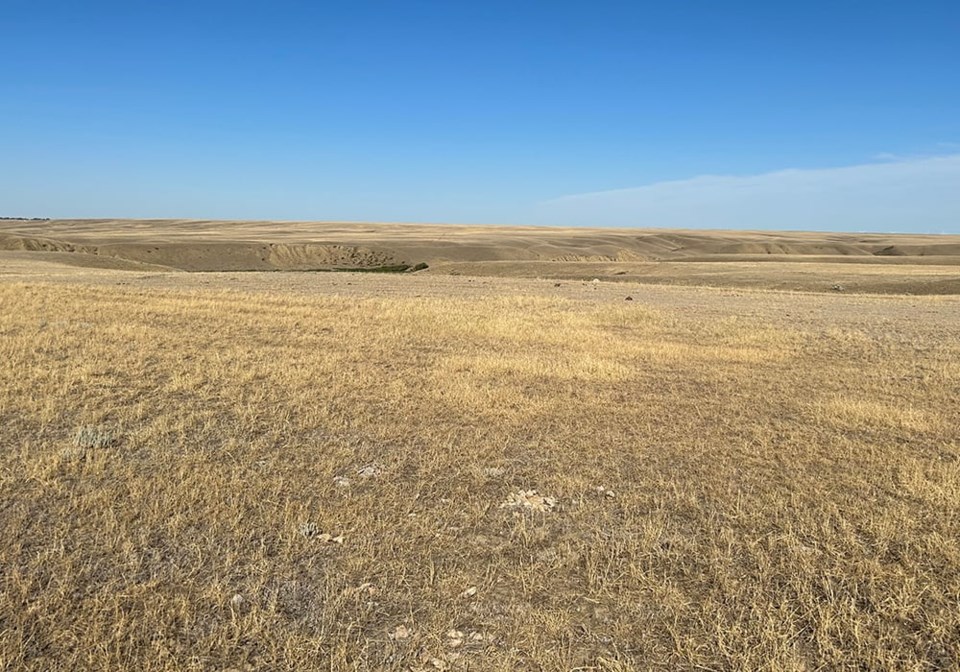WESTERN PRODUCER — The newly appointed federal agriculture minister and his Alberta counterpart discussed a range of topics during their first meeting, which took place in Calgary the first week of August.
Alberta’s RJ Sigurdson and the feds’ Lawrence MacAulay talked about challenges such as the potential of an outbreak of African swine fever and international trade protocols.
However, the drought plaguing Canada’s cattle country appeared to take centre stage.
Brodie Haugan, Alberta Beef Producers chair, said his organization took part in those discussions, which included other cattle industry groups and crop organizations, relaying the message that both short- and long-term solutions to persistent drought are needed.
“This is the fourth year of severe drought, so it’s been a constant conversation within ABP. But this year it’s probably the worst it’s ever been,” said Haugan.
That’s largely due to the cumulative effect of consecutive dry seasons that have seen pastures worn out with little reprieve across much of southern Alberta and the heart of the country’s cattle sector.
Though this year’s drought is affecting a smaller portion of the province than 2021’s prairie-wide situation, which hit both pasture and crops, the impact in many ways is more menacing.
“The compounding effects of drought have just absolutely nailed our producers yet again,” said Haugan.
“We’re seeing some pretty drastic things happening right now and we’re doing everything we can to stay ahead of it. But, at the end of the day, if you don’t have grass, you don’t have feed, you don’t have many options.”
The main fear within the industry has been the shrinking beef cattle herd, along with the loss of cow-calf producers. Lack of available feed continues to drive the decades-long trend of selling more cattle.
“As land stewards, we always try to ensure we leave some carry-over grass, leave some extra feed in the stockpiles. But year after year of drought, eventually there just isn’t anymore to give, anymore in your stack,” said Haugan.
“What we’re seeing across the province is pastures which are just done. They need recovery, they need rain, they need moisture and the hard part about it is that one good rainfall doesn’t solve this problem.”
It will take at least a couple of years of decent precipitation to bring the native pastures up to average levels, he added.
The situation comes at a time of record demand for beef along with positive market signals for the industry. But to take advantage of the situation, changes are needed to business risk strategies.
Alberta triggered the AgriRecovery program assessment process earlier this summer. Producers are now waiting for the results from the federal government.
If successful, that program could provide stability to cattle inventories, depending on the shape the initiative takes.
“It’s good to trigger AgriRecovery, but it’s even better if they trigger it today because right now is when producers need the help,” said Haugan.
“Right now is when we are incurring the cost for the feed that’s going to get us through the winter. It’s right now we are incurring costs for the feedlots that are feeding the cows that don’t have pasture.”
The longer that process takes, the more stress it will put on producers, “and the more likely it is we’re going to continue to see cows going to town,” he added.
One of the topics discussed by Sigurdson and MacAulay was the future of the AgriStability program.
Haugan said there are positive discussions about changes to that program, which will provide a better business risk management tool for cattle producers in the long term.
One avenue being explored to address this year’s feed shortage is, as in 2021, importing dried distillers grain and corn from the United States.
JGL Commodities is advertising corn, DDG and canola meal for sale out of its Moose Jaw and Woodrow locations.
Glen Loyns, JGL general manager, said the infrastructure developed to move feed north of the border in 2021 is still there and could once again give relief to producers.
“We’re unsure about what the crop is going to be like this year for feed, so we’re becoming prepared to bring in other feed alternatives into the market space,” he said.
“Corn’s been trading in Alberta for this new crop already, and now it’s stalled, and we are waiting to see what the actual crop in Western Canada is going to look like.”
That picture will become clearer by the end of August, said Loyns.
“The railways are set up so they can import corn into Canada pretty easily, whereas a few years ago, the infrastructure wasn’t there to support the corn trade. Now it’s there,” he said.
You can no longer count on social media to deliver important news to you. Keep your news a touch away by bookmarking SASKTODAY.ca's homepage at this link.
Here's why you should bookmark your favourites.

